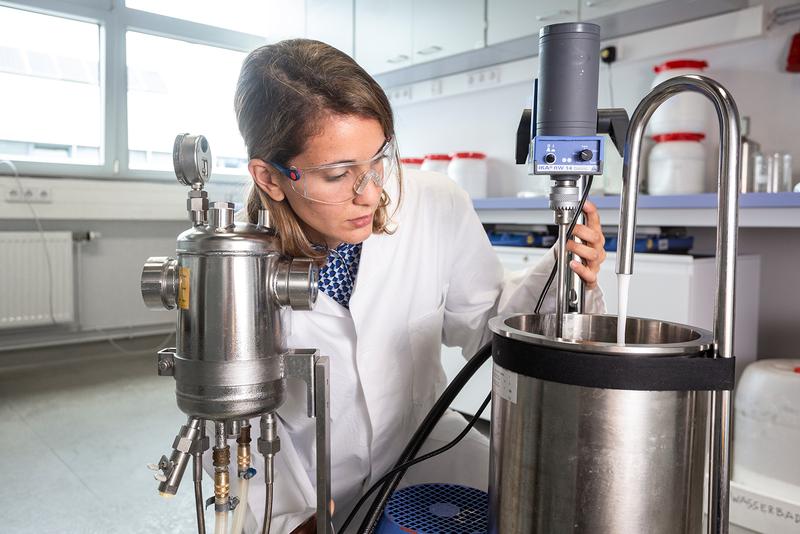Reducing Energy Consumption With Phase Change Materials
Phase change materials (PCMs) are an important building block for efficient thermal management. They can be used to conserve energy. Researchers at the Fraunhofer Institute for Solar Energy Systems ISE have teamed up with industry partners to develop emulsions made from PCMs and water or mixtures of water and glycol for applications such as air conditioning inside buildings and cooling industrial machinery. The new PCM emulsions achieve storage density twice that of water.
Water has proven its value as a heat carrier, for example when it comes to transferring heat from a boiler to a radiator or keeping cooling ceilings chilled. But there is a new contender on the scene: In the Optimus project, researchers at Fraunhofer ISE in Freiburg are working with partners from industry to develop PCM emulsions with high storage density for use in buildings and industry but also in heat pump systems and to cool batteries in motor vehicles.
Surfactants stabilize ultrafine emulsified paraffin droplets
The PCM emulsions are a mix of paraffins and water or water-glycol mixtures, which are used primarily in the mobility sector, where the addition of glycol keeps the mixture from freezing. The researchers use paraffins that are dispersed or emulsified in water or the water-glycol mixtures. Surfactants stabilize the ultrafine paraffin droplets distributed throughout the water, which lends the mixture thermal and mechanical stability. The emulsions use the high energy density of paraffins during the phase transition from solid to liquid. “Because we emulsify the paraffins in water, they can remain liquid regardless of their phase state in the emulsion that is created and be used as heat transfer liquids in heating and cooling networks, meaning that the mixtures can be pumped through pipes. During the phase change, the PCMs absorb or release large amounts of heat even as their temperature remains constant,” explains Stefan Gschwander, a research scientist at Fraunhofer ISE. This allows the researchers to achieve twice the storage density of water — which is currently used as a heat carrier in conventional heating and cooling supply networks — in the PCM melting range while keeping the volume the same.
In addition to their high storage density, PCM emulsions also have a number of other advantages. Owing to their high heat storage capability, systems that use PCMs can be designed to take up less space. They offer high heat capacity, especially where the temperature differential is small. “The use of PCMs is especially interesting for applications that permit only minimal temperature differences, such as building cooling or air conditioning. Conventional air conditioning systems that use water as a heat carrier require high volumetric flows and large storage volumes. This is where PCMs really shine,” Gschwander says.
Customized PCMs with different melting temperatures
In the project, the partners are developing suitable PCM emulsions with melting temperatures ranging between 12 and 18 degrees Celsius, 20 and 28 degrees Celsius and 45 and 50 degrees Celsius for any application, from air conditioning in buildings to industrial facilities, battery cooling and heat pumps. All of the emulsions that have been developed have already undergone thermomechanical testing in a hydraulic test circuit with a centrifugal pump, various valves, a diaphragm expansion tank and a plate heat exchanger. They can withstand up to 100,000 cycles. The researchers initially developed, characterized and tested the PCM emulsions at the lab scale, using production volumes of up to five liters. Then the formulas were scaled up to the pilot plant scale, producing volumes of up to 100 liters.
Plans call to scale up the PCM emulsions even more, to the cubic meter scale, in collaboration with industry partner H&R Wax & Specialties GmbH. The goal is to produce the emulsions in greater volumes to demonstrate their use in cold reservoirs used for indoor air conditioning or process cooling. The PCM emulsions will initially be provided for two demonstrations. In the first one, waste heat from the server rooms in a court building will be stored during active heating and later transferred to the air supply via the emulsion, making that thermal energy available to help heat the building. In the second application, plans call for cooling injection molding machines and releasing the heat stored at peak times into the cool outdoor air (free cooling) at night. “Right now, we are optimizing our formulas to achieve even greater stability and storage density,” Gschwander explains.
The Optimus project
Development, optimization and application of PCM emulsions with high thermal storage density
Duration:
May 2021 to April 2026
Project funded by:
German Federal Ministry for the Environment, Climate Action, Nature Conservation and Nuclear Safety
Project partners:
• Fraunhofer ISE
• H&R Wax & Specialties GmbH
• Hochschule RheinMain
• IKS Industrielle KühlSysteme GmbH
• Konvekta AG
Weitere Informationen:
https://www.fraunhofer.de/en/press/research-news/2025/juli-2025/reducing-energy-consumption-with-phase-change-materials.html
Die semantisch ähnlichsten Pressemitteilungen im idw


